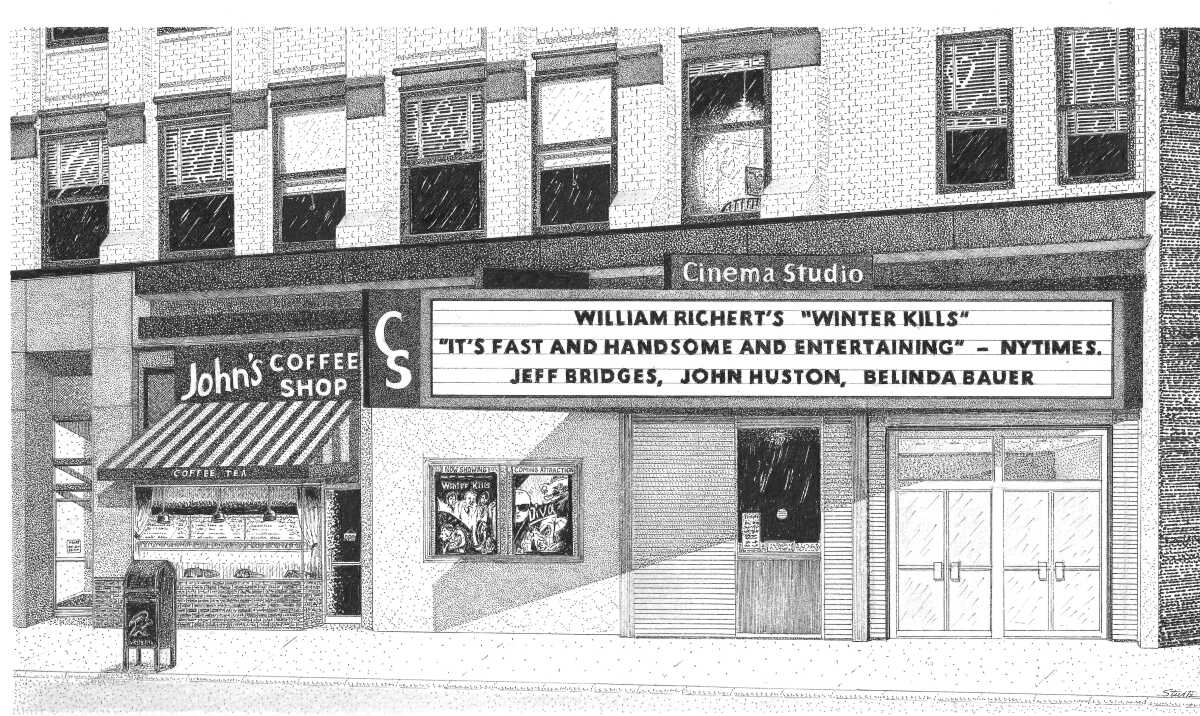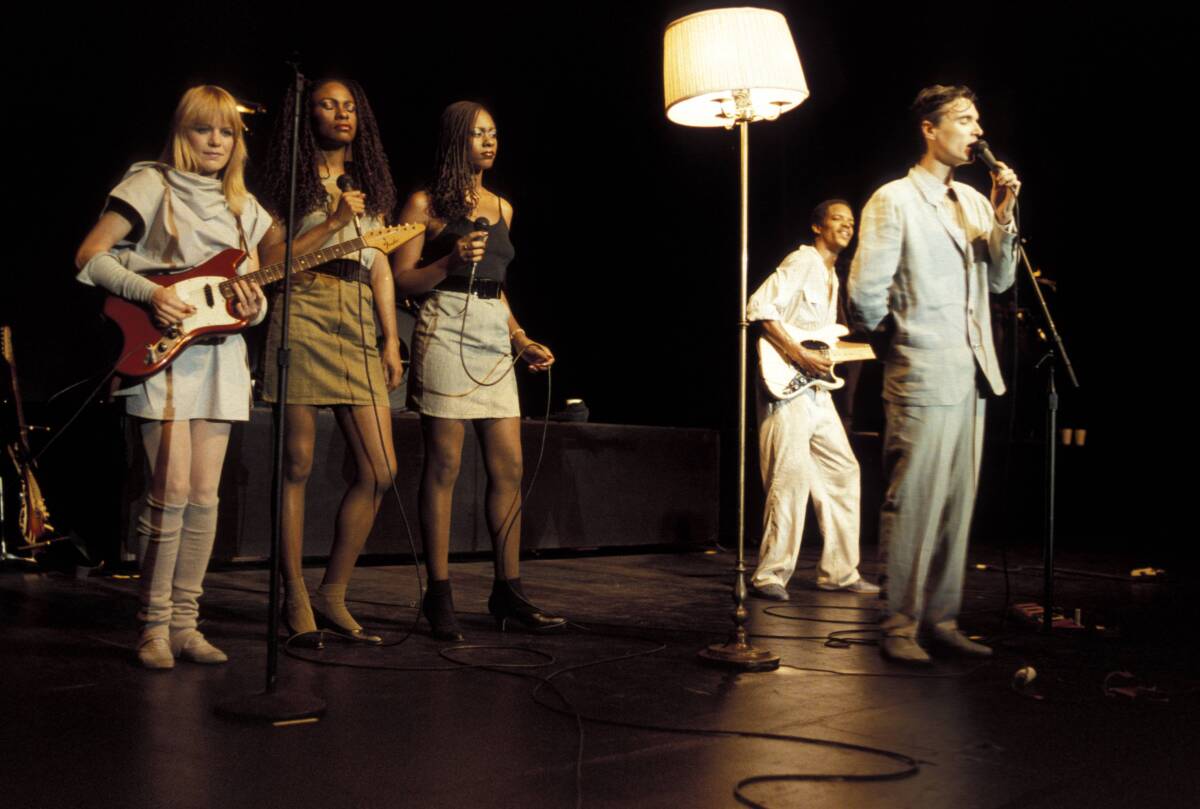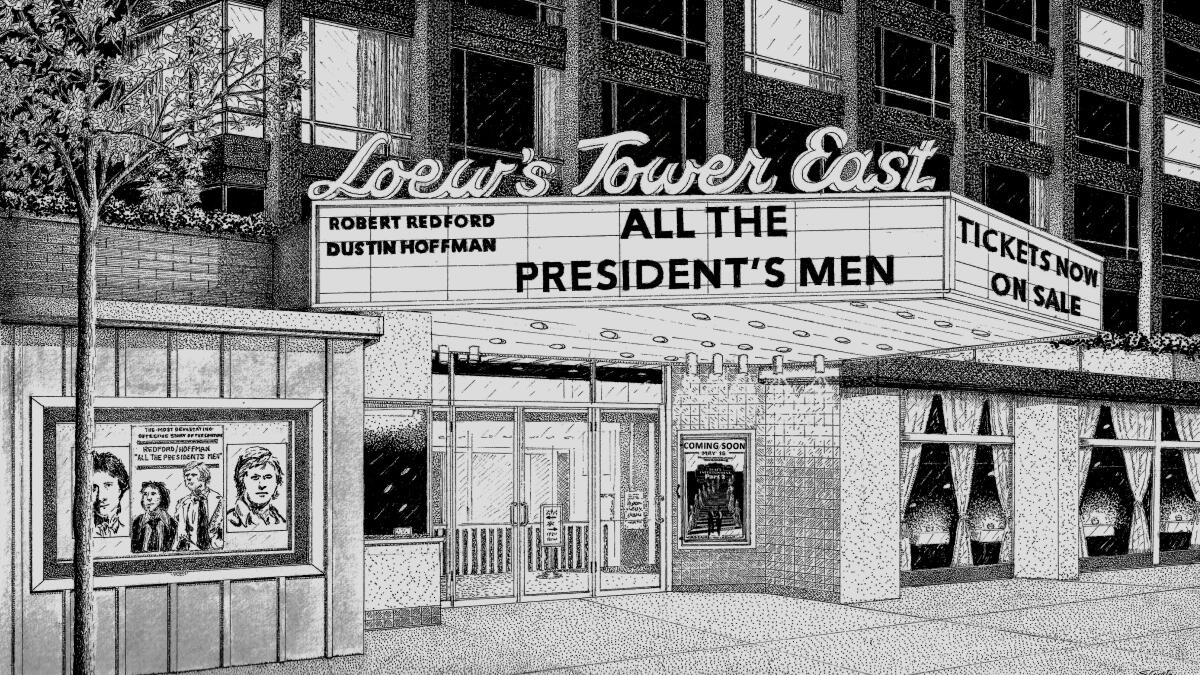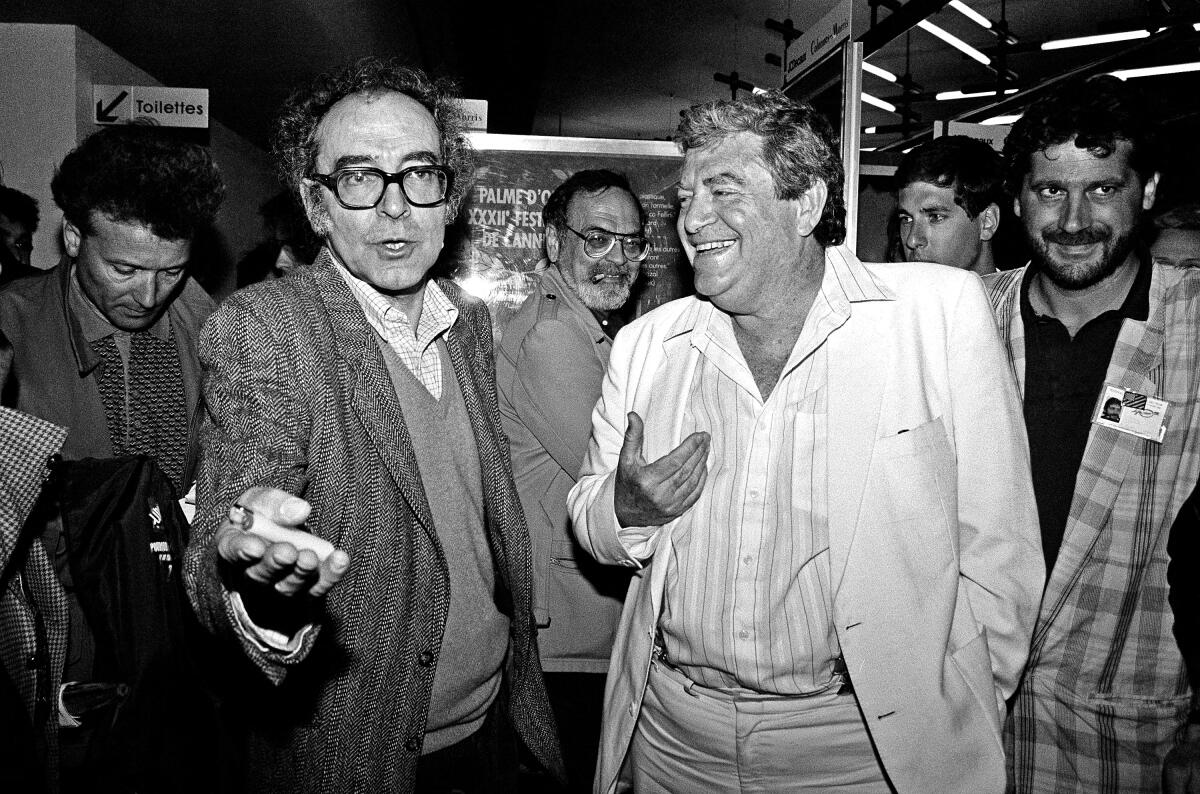Richard Shepard’s memories as a teenage ‘Film Geek,’ plus the week’s best movies in L.A.

- Share via
Hello! I’m Mark Olsen. Welcome to another edition of your regular field guide to a world of Only Good Movies.
Talking Heads in L.A.

Following the world premiere last week in Toronto of the new 4K restoration of Jonathan Demme’s celebrated concert film “Stop Making Sense,” this week there was something of a Talking Heads takeover in Los Angeles. All four members of the group appeared at Vidiots on Monday for a conversation moderated by Kim Gordon. They were joined by Ednah Holt and Lynn Mabry, backup singers for the band, as well as musician Steve Scales, whose ebullient screen presence steals a number of moments in the film.
Then the whole troupe appeared again at the Aero Theatre on Tuesday for a conversation moderated by Paul Thomas Anderson. The director, a friend and avowed acolyte of the late Demme, also brought to the stage Gary Goetzman, producer of the film and the boyhood inspiration for Anderson’s “Licorice Pizza.” After cajoling some wild and warm stories from Goetzman about the making of the concert film, Anderson joked, “In the sequel to ‘Licorice Pizza,’ we’ll do the making of ‘Stop Making Sense.’”
Rob Tannenbaum spoke to all four members of Talking Heads — David Byrne, Chris Frantz, Jerry Harrison and Tina Weymouth — in Toronto. Byrne described the film’s rough narrative as: “There’s a guy who is not that comfortable socially, very anxious and nervous, and he gradually finds community and a way to let go, through music and dancing. He finds a way to be more comfortable, and he finds joy.”
The film is now playing for one week exclusively in Imax theaters, then in regular theaters everywhere Sept. 29. The sound on the new restoration is revelatory, even for people who know the original film and record inside out. This makes for one of the most joyful moviegoing experiences of the year.
Only good movies
Get the Indie Focus newsletter, Mark Olsen's weekly guide to the world of cinema.
You may occasionally receive promotional content from the Los Angeles Times.
Richard Shepard’s ‘Film Geek’

The world premiere of “Film Geek” happens tonight at the American Cinematheque’s Los Feliz 3. The deeply personal essay film is by Richard Shepard, a veteran director of film and TV whose credits include movies such as “The Perfection,” “Dom Hemingway” and “The Linguine Incident,” as well as episodes of “Zoey’s Extraordinary Playlist” and “Girls.” Shepard will be present for the screening, followed by a Q&A moderated by “Ed Wood” screenwriter Larry Karaszewski.
The film explores Shepard’s love of movies through clips from more than 200 films interwoven with movies made by Shepard and his friends when they were in high school, as well as deeply intimate details of his family life. The roll call of films ranges from the highbrow to the decidedly grungy, the menu of a true movie fanatic. Working with editor Adam Lichtenstein, Shepard rewrote the narration to fit the footage as they assembled it.
The film will feel instantly recognizable to anyone with their own deep-seated love of movies, the intertwining of memories of specific films with personal ones. Early in the film there is a deep exploration of the time Shepard and his father saw William Richert’s “Winter Kills.”
“Obviously everything that I write, all my movies, parts of it are personal, but nothing has really been personal specifically,” Shepard said during a phone call this week from his home in Los Angeles. “And I wanted to dive in and really think about my childhood and my dad and movies and all of that stuff. And it was actually much more difficult than I imagined. I thought it was going to be kind of fun and breezy, and lots of it obviously was, but it was tough talking about my dad that way and sort of figuring things out.
“At a certain point I realized it was actually more than just for me, which is what it started as,” he continued. “It is obviously my story, but anyone who grew up as a film lover will relate to definitely parts of it. Because we’re all similar and even if our stories are different, we all had a first movie, had a first horror movie, had a first R-rated movie. All those things are rites of passage for anyone who loves movies.”
Very much a child of New York City, Shepard recounts coming across the production of films such as “The Cotton Club” and “Dressed to Kill” and how he wandered onto the set of “Annie” and stood near director John Huston for hours with no one bothering him, presumably because they assumed he must have been someone’s kid and there for a reason.
Shepard also gives special attention to the theaters where he saw these films, most of them long since gone. Sketches by artist Skip Sturtz re-create the façades and marquees of these forgotten havens, with names like the Town and Country, the Coronet, the Baronet, the Gemini, the Embassy and the Thalia.
“There’s not a lot of archival photography of these movie theaters, but to me they were just so important,” says Shepard. “And I still know what theaters I saw all those movies in high school. I don’t really remember anything from last week, but I can tell you where I saw ‘Blood Beach’ in 1982.
“So I wanted these drawings to be able to be like here’s how I remember these movie theaters,” says Shepard. “I just look at those photos and those drawings and I’m just transported back. And I think part of the fun of this movie is if you grew up in New York City in the late ’70s, early ’80s, I hope to have captured some of that film energy in the documentary. And even if you didn’t, hopefully you could enjoy sharing my passion for it.”
Shepard doesn’t entirely know what he expects the life of the film to be. Though a movie made up largely of clips from other movies has obvious post-theatrical complications, a fair-use lawyer has vetted the film and says it should be clear for any future showings.
“This is our first public screening,” says Shepard. “I’m hoping that people will see it and word will spread and there’ll be some incoming phone calls. That would be the thrill of a lifetime. Honestly, I feel like there is an audience for this movie, but we’re going to just take it one screening at a time.
“In a way, I wouldn’t want this movie be screened without me there. I feel like if it’s going to be screened in someone’s home, I want to come over for dinner and then talk to them afterward.”
Godard’s ‘King Lear’

It was just a little over a year ago that Jean-Luc Godard died, and so Whammy Analog Media in Echo Park has been presenting some of the filmmaker’s lesser-known works. Tonight it will screen 1987’s “King Lear,” among Godard’s most confounding films — and that’s saying something.
Not so much an adaptation of Shakespeare’s play as a film on the nature of adaptation itself, “King Lear” stars theater director Peter Sellars as William Shakespeare, Jr., the Fifth, who has been sent by the Queen of England to rediscover Shakespeare’s works after they have been lost following a nuclear disaster. Among the cast are Norman Mailer, Burgess Meredith, Julie Delpy, Leos Carax, Woody Allen and Molly Ringwald. Incongruously, the film was produced by the notorious Cannon Films, makers of rough-and-tumble action films starring the likes of Chuck Norris and Charles Bronson.
In the confessional spirit of Shepard’s “Film Geek,” I will acknowledge that Godard’s “King Lear” was among the very first art films I was ever exposed to — I went to see it because of Allen and Ringwald — and it frankly split my brain open. Worn out by sheer confusion, at one point I dozed off, reawakening fully immersed in a world I did not understand but somehow intuited. I’ve likely been trying to re-create that experience ever since.
Only Godard would even attempt the cultural high-wire act that is “King Lear” and only Godard would have so little regard for whether it works. The movie was largely rejected when it was first released, and though it has found some champions along the way, notably the New Yorker’s Richard Brody, who regularly declares it the greatest film of all time, it is still most widely seen as a misbegotten misfire. The film has never been released on DVD or Blu-ray in the U.S. and the Whammy screening will be a projection from a VHS tape, which should add another layer of murk and mystery.
Other points of interest
John Waters at the Academy Museum The new exhibition “John Waters: Pope of Trash,” celebrating the career of the Baltimore-born filmmaker, has opened at the Academy Museum, and while there is something breezy and fun about it, the exhibit also takes Waters seriously as an artist in a way that is refreshing and inspiring. His lifelong assault on the conventions of good taste is a reminder that canons do change, and what may seem like the work of an outsider may someday be seen quite differently.
Waters himself was in town for the opening last weekend, attending a few screenings, but even if the filmmaker won’t be in attendance, there is still plenty to see. Audience interest in both 1972’s landmark “Pink Flamingos,” playing Saturday, and 1974’s “Female Trouble,” playing Thursday, was so strong that they were moved to the Academy’s bigger theater. Other upcoming screenings include 1981’s “Polyester,” 1988’s “Hairspray” (the best point of entry for the uninitiated and Waters-curious) and 1977’s “Desperate Living.” The series will end later in October with double bills of “Pecker” and “Cry-Baby” along with “Cecil B. Demented” and Waters’ last film to date, “A Dirty Shame.”
“It’s easy to shock,” Waters said to Manuel Betancourt for The Times. “It’s not easy to startle and make [people] laugh and change things. I learned at school the term shock value. You say something outrageous to get someone’s attention and have them listen. I knew it worked. But I never tried to top the shock of ‘Pink Flamingos’ once I won. And I did win. It’s easy to shock people. But that doesn’t mean it’s funny or witty or good. Everybody can be disgusting — it has to be disgusting and funny,”
Alan Rudolph and Carolyn Pfeiffer at the Cinematheque The American Cinematheque also hosts a tribute to idiosyncratic filmmaker Alan Rudolph and prolific producer Carolyn Pfeiffer this weekend. On Saturday there will be a double bill of 1985’s “Trouble in Mind,” starring Kris Kristofferson, Keith Carradine and Lori Singer, with 1985’s “The Moderns,” starring Carradine, Geraldine Chaplin and Linda Fiorentino. Sunday will see a double bill of 1984’s “Choose Me,” starring Carradine, Geneviève Bujold and Lesley Ann Warren, with 1978’s “Remember My Name,” starring Chaplin, Anthony Perkins and Berry Berenson.
In his original Times review of “The Moderns,” Michael Wilmington noted, “It’s a sweet, devious meditation on art, love, life and artifice: the most special and delightful of all Rudolph’s films. Like many of them, it seems at first weirdly casual. But the movie blooms as you watch it. It’s certainly pretentious. But it’s so amused at its own pretensions, it plays with them so magically, that you can’t — or shouldn’t — be disturbed.”
These titles rarely screen in theaters, so it‘s worth catching them while there’s a chance. Pfeiffer will also be signing copies of her new memoir, “Chasing the Panther: Adventures and Misadventures of a Cinematic Life.”
“Streets of Fire” at Vidiots One movie that has really gained in popularity over the past few years is Walter Hill’s 1984 action-musical hybrid “Streets of Fire,” which screens tonight at Vidiots. Building from the success of “48 Hrs.,” Hill and screenwriter Larry Gross, along with producers Lawrence Gordon and Joel Silver, really went for it with a movie described in the opening titles as “a rock & roll fable” that takes place in “another time, another place.” Diane Lane, Michael Paré, Amy Madigan, Rick Moranis and Willem Dafoe lead the cast in a story of warring motorcycle gangs, a kidnapped singer and the loner who is determined to bring her back.
When I spoke to Hill last year, he said of the film, “Even though it had action things in it, it was my attempt at a musical. I knew it was close as I would ever get to do a musical. And I like musicals, but I wasn’t going to do the Vincente Minnelli. I was incapable of that. But I thought I could do something with pop music and mixing genres and it was very experimental in its way.”
Only good movies
Get the Indie Focus newsletter, Mark Olsen's weekly guide to the world of cinema.
You may occasionally receive promotional content from the Los Angeles Times.




